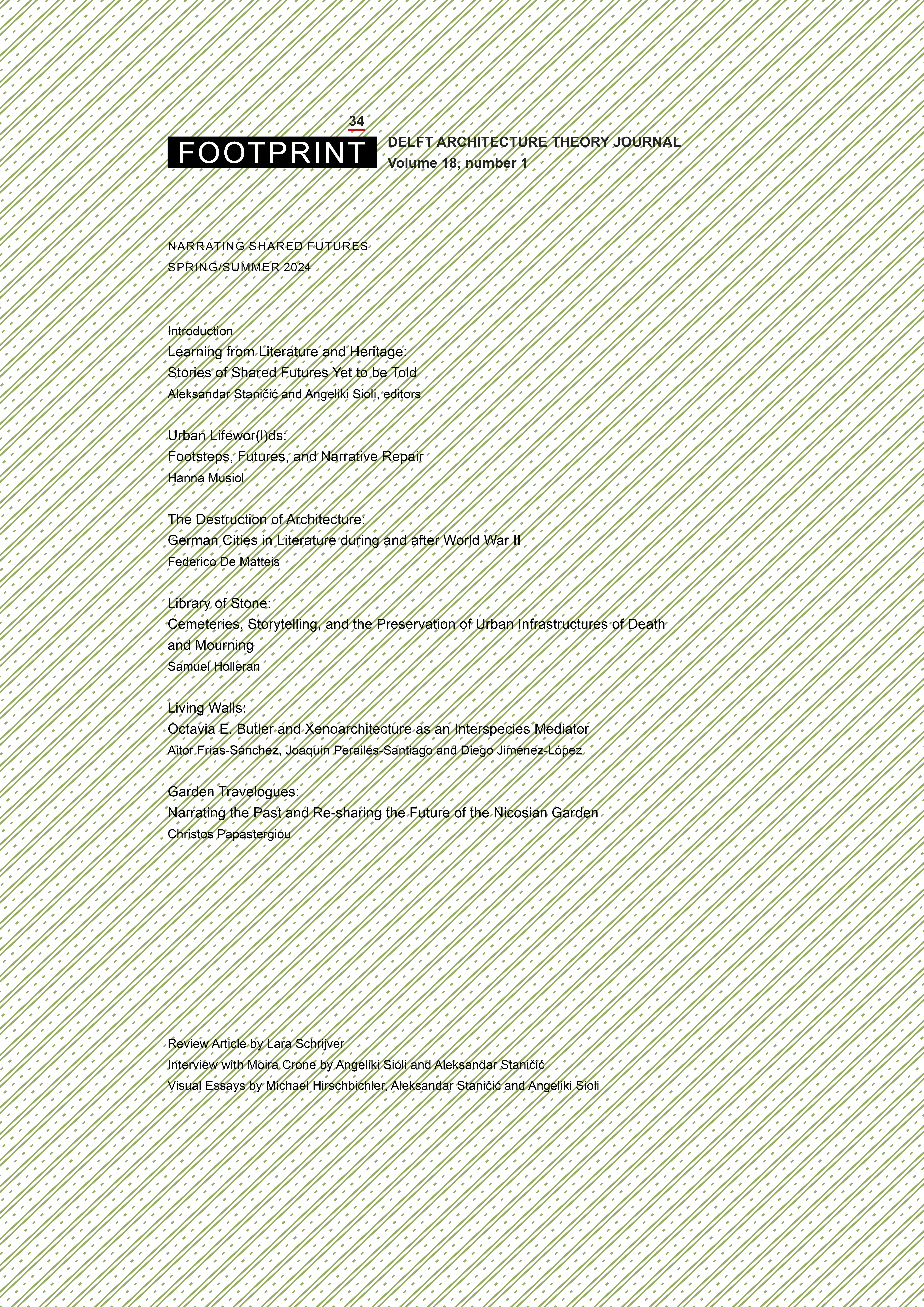Library of Stone
Cemeteries, Storytelling, and the Preservation of Urban Infrastructures of Death and Mourning
DOI:
https://doi.org/10.59490/footprint.18.1.6956Abstract
This article examines cemeteries as repositories for vernacular literary culture, in the form of epitaphs, and as the inspiration for literature that brings necrogeography into tension with programmes of growth. It starts in the early nineteenth century, when Romantic period notions of individuality, intertwined with the novel, gave birth to modern cemeteries. These spaces have, in the interceding centuries, grown old and been threatened by expanding cities, infrastructure, and changing modes of memorialisation. As sprawling cities encroach on cemeteries, ‘perpetual rest’ has been challenged and headstones have been removed or consolidated, to make way for parks and amenities that benefit the living. Literary depictions of cemeteries in the twentieth century have both reinforced, and troubled the notion, that cemeteries are ‘archives in stone’ that must be protected at all costs.
References
Ariès, Philippe. Western Attitudes toward Death: From the Middle Ages to the Present Baltimore: Johns Hopkins University Press, 1975.
Chapman, Alison. ‘The Aura of Place: Poetic Form and the Protestant Cemetery in Rome’, in Travel Writing, Visual Culture, and Form, 1760-1900, Eds. Mary Henes and Brian H. Murray. London: Palgrave Macmillan, 2016.
Coutinho, Isabel. ‘Cinzas de José Saramago repousam finalmente à sombra de uma oliveira na Casa dos Bicos’, Público, 19 June 2011.
DeLillo, Don. White Noise. New York: Penguin, 2009 [1984].
Dethlefsen, Edwin and James Deetz. ‘Death’s Heads, Cherubs, and Willow Trees: Experimental Archaeology in Colonial Cemeteries,’ American Antiquity, 31:4 (1966): 502-510.
Firth, Raymond. ‘Forward: The Body in the Sacred Garden’, in The Secret Cemetery, Eds. Doris Francis, Georgina Neophytou, and Leonie Kellaher. Oxford: Berg, 2005.
Herat, Manel. ‘The Final Goodbye: The Linguistic Features of Gravestone Epitaphs from the Nineteenth Century to the Present,’ International Journal of Language Studies 8, no. 4 (October 2014): 127–50.
Holleran, Samuel. ‘Cheeky Monuments: Photo-Engraved Headstones and Image Moderation in Cemeteries’, photographies, vol 16:1 (2023): 49-69.
Howell, Kathryn, Gough, Meghan, and Cameron, Hannah. ‘“Why are we asking for a seat at the table that our ancestors created for us?” The importance of cultural landscapes and power in urban planning.’ Journal of Urban Affairs, vol 16 (2023): 1-22.
Laqueur, Thomas. The Work of the Dead: A Cultural History of Mortal Remains. Princeton, NJ: Princeton University Press, 2015.
Longworth, Philip. The Unending Vigil: A History of the Commonwealth War Graves Commission, 1917-1984. Ann Arbor: University of Michigan, 1985.
Loudon, John Claudius. On the Laying Out, Planting, and Managing of Cemeteries; and on the Improvement of Churchyards. London: Longman, Brown, Green, and Longmans, 1843.
Maddrell, Avril and Sidaway, James D. (eds) Deathscapes: Spaces for Death, Dying, Mourning and Remembrance Farnham: Ashgate, 2010.
‘Philip Roth Discusses “Everyman”‘, National Public Radio, 8 May 2006, available at: https://www.npr.org/2006/05/08/5390578/philip-roth-discusses-everyman.
Roth, Philip. Everyman. New York: Houghton Mifflin, 2006.
Roth, Philip. Sabbath’s Theater. New York: Houghton Mifflin, 1995.
Roth, Philip. The Anatomy Lesson. New York: Farrar, Straus & Giroux, 1983.
Roy, Arundhati. The Ministry of Utmost Happiness. London: Penguin, 2017.
Rugg, Julie. ‘Defining the place of burial: What makes a cemetery a cemetery?’ Mortality, vol 5:3 (2000): 259-275.
Saramago, José. All the Names, translated from the Portuguese by Margaret Jull Costa. New York: Harcourt, 1999.
Saul, Nigel. English Church Monuments in the Middle Ages: History and Representation Oxford: Oxford University Press, 2009.
Saunders, George. Lincoln in the Bardo. New York: Random House, 2017.
Sloane, David Charles. Is the Cemetery Dead? Chicago, University of Chicago Press, 2018.
Stacey, Michelle. ‘Writ in Water’, The Paris Review, 23 February 2016.
Tolstoy, Leo. What Men Live By, and Other Tales. Boston: T.Y. Crowell, 1888; Google Books, 2007.
Wright, Elizabeth A. ‘Rhetorical spaces in memorial places: The cemetery as a rhetorical memory place/space’, Rhetoric Society Quarterly, vol. 35:4 (2005): 51-81.
Downloads
Published
Issue
Section
License
Copyright (c) 2024 Samuel Holleran

This work is licensed under a Creative Commons Attribution 4.0 International License.
- Authors retain copyright and grant the journal right of first publication with the work simultaneously licensed under a Creative Commons Attribution License that allows others to share the work with an acknowledgement of the work's authorship and initial publication in this journal.
- Authors are able to enter into separate, additional contractual arrangements for the non-exclusive distribution of the journal's published version of the work (e.g., post it to an institutional repository or publish it in a book), with an acknowledgement of its initial publication in this journal.





